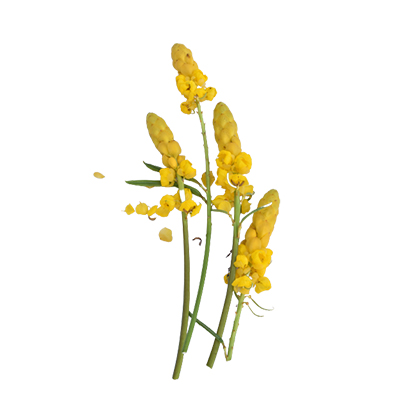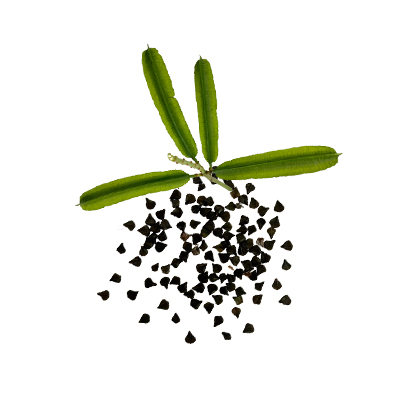Ringworm Bush
Senna alata (L.) Roxb.
Fabaceae
Location in our garden
Principal
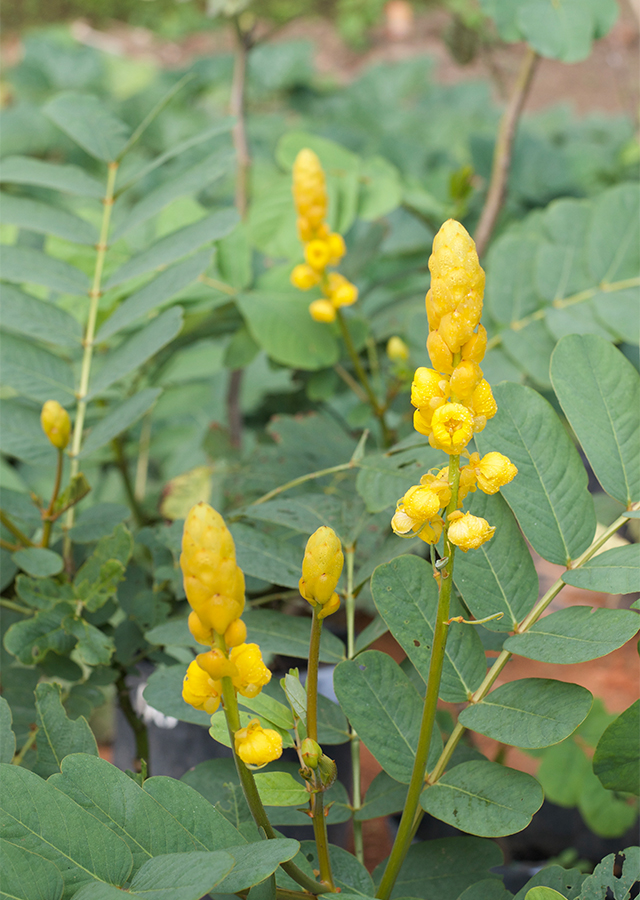
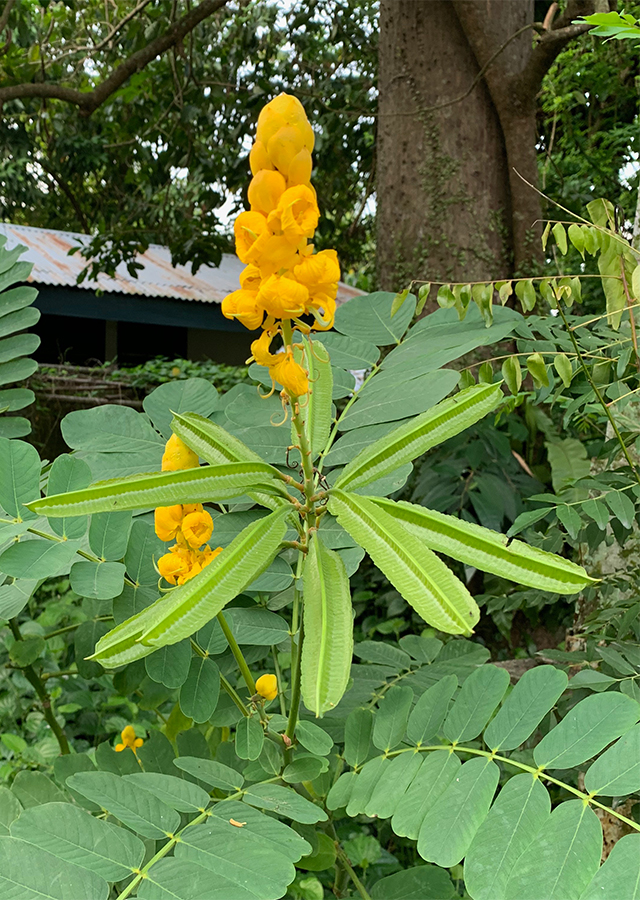
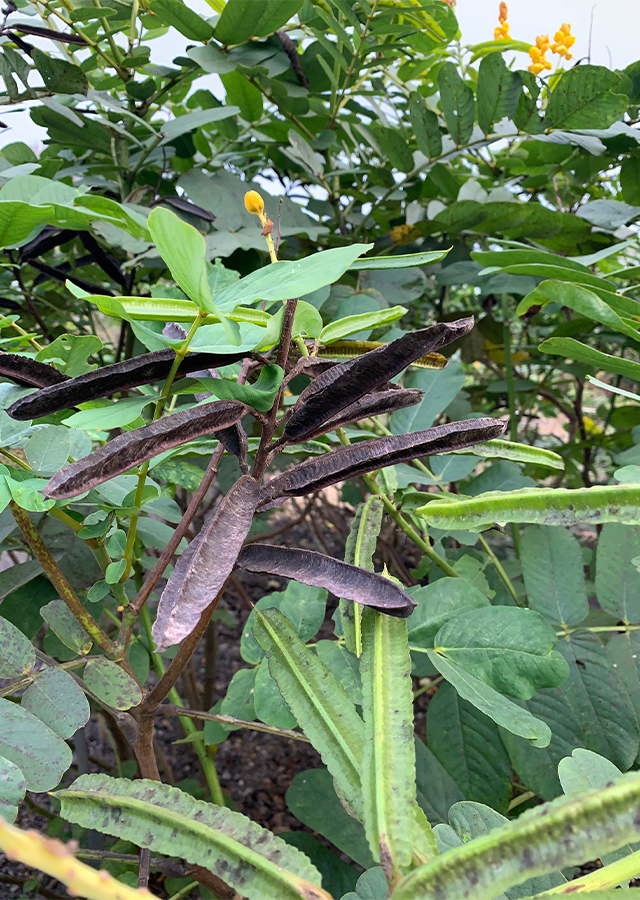
Synonym
Cassia alata L.
Cassia arayatensis Naves ex Fern.-Vill.
Cassia bracteata L.f.
Habitus
Shrubs. A fast growing, soft wooded perennial shrubby plant, about 1-3 m tall.
Part Used
Leaves
Seeds
Flowers
Fruit
Roots
Stem
Growing Requirements
Full Sunshine
Drought Resistant
Habitat
Riverbanks
Forest
Roadside
Shrublands
Grassland
Overview
Ringworm bush is native to tropical South America and is commonly cultivated as an ornamental and medicinal plant in tropical and subtropical regions around the world. It has been reported to have naturalised in Asia, Indonesia, Africa, the southern half of North America, Central America, the Caribbean, South America, and Oceania. It is also known as the "King of the Forest," which is an ornamental plant that blooms yellow flowers.
Vernacular Names
Ketepeng (Indonesia), Chi jia jue ming (Chinese), Bois dartre or Catépen (French), Kharpat (India), Kerzenstrauch (German), Kasshia arata (Japanese), Gelenggang (Malaysia).
Agroecology
Ringworm bush is found in diverse habitats, is drought tolerant and grows best in full sun. It grows at low to medium altitude but can also be found up to 1,400 m. It grows on soils that are heavy to sandy, acidic to slightly alkaline, and well-drained, with a pH of 5.6 to 7.8. It grows in locations with 600–4300 mm of annual rainfall and average annual temperatures of 15–30 °C.
Morphology
- Stems - marked with leaf scars and persistent stipules.
- Leaves - about 50–80 cm long, alternate, pinnate, with 8–14 pairs of large leaf-lets (the distal ones largest), up to 17 cm long, ovate-oblong, obtuse, truncate or even slightly notched at apex, margin entire, subsessile.
- Flowers - The inflorescence is a long pedunculate, erect, dense, oblong spike, terminal or axillary, 10–15 cm long, with overlapping and crowded yellow flowers, 4 cm in diameter. Flowers are surrounded by dark-yellow or orangey bracts that shed during flowering, bisexual, zygomorphic and pentamerous, with 5 oblong sepals, 5 bright yellow ovate orbicular petals, elongated recurved, pubescent ovary with short slender style and stigma.
- Fruits - Pod is green, maturing brown to black, straight, papery in texture, winged, up to 15–20 cm long and barely more than 1 cm wide.
- Seeds - seeds numerous (to 50), shiny, flat and triangular.
Cultivation
Senna alata is propagated by seed or cuttings. Soaking the seeds overnight before sowing enhances germination.
Chemical Constituents
Anthraquinone derivatives: rhein (cassic acid), rhein-anthrone and aloe-emodin-anthrone, flavonoid (e.g. kaempferol, glycosides), tannins, alkaloids, krisofanat acid (dehydroxy methillantroquinone).
Traditional Medicinal Uses
- The wood is used in decoctions to treat liver disorders, urticaria, rhinitis, and loss of appetite induced by gastrointestinal problems.
- The leaves are used as a purgative, and decoctions of the leaves are used as an expectorant in bronchitis and dyspnea, as an astringent, a mouthwash, and an eczema wash.
- Crude leaf extracts have shown antibacterial activity against Dermatophilus congolensis, which causes a serious skin ailment in cattle, antifungal properties, and antitumor activity. Internally, it is used to treat constipation and to purify the blood. As a therapy for biliousness and hypertension.
- The plant is anti-inflammatory, diuretic, analgesic, vulnerary, hypoglycemic, and antisplasmodic.
- The flowers are used as a laxative, vermifuge, also used for remedying spleen conditions .
- Root and seed are laxative.
- The seed is cooked and used as a remedy for intestinal worms.
- The leaves, flowers and fruit are mixed in an infusion to treat stomach problems.
- Bark is used to treat skin diseases, diarrhoea, worms, parasitic skin diseases, scabies and eczema.
- A root infusion is used to treat diarrhoea, tympanites, uterus problems, and filaria worm expulsion. It is also used on the skin to treat sores and skin fungus.
Part Used
Reference Sources
- CABI (2016). Invasive Species Compendium. Senna alata. https://www.cabi.org/isc/datasheet/117090 (Accessed 20-07-2020)
- Fern, Ken. (2019). Useful Tropical Plants Database. Senna alata (L.) Roxb. http://tropical.theferns.info/viewtropical.php?id=Senna+alata (Accessed 19-09-2020)
- Lim, T. K. (2014). Senna alata. In Edible Medicinal And Non-Medicinal Plants. Springer Science+Business Media, Dordrecht. DOI 10.1007/978-94-007-7395-0_2.(Accessed 30-11-2021) .
- Motaleb, M. A., & International Union for Conservation of Nature and Natural Resources. (2013). Commonly used medicinal herbs and shrubs by traditional herbal practitioners: Glimpses from Thanchi upazila of Bandarban. Dhaka: International Union for Conservation of Nature and Natural Resources. pp.169-170.
- Hernandez, H.P. 1999. Senna Miller. In: de Padua, L.S. Bunyapraphatsara, N. and Lemmens, R.H.M.J. (Editor ): Plant Resources of South-East Asia No 12(1). Medicinal and poisonous plants 1. Backhuys Publishers, Leiden, the Netherlands. pp 443-447.



